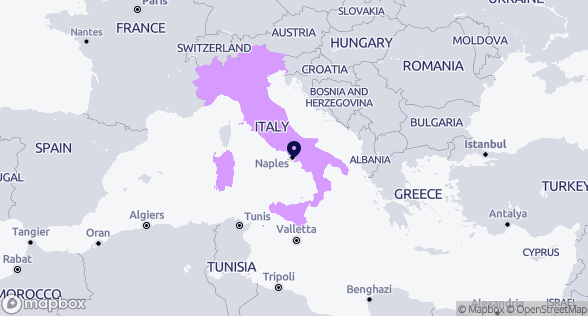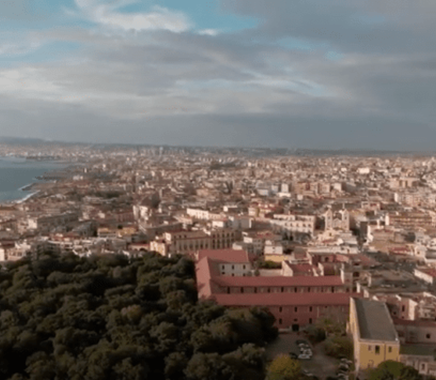
Portici
Italy
About Air Heritage
This is a citizen science project tackling the challenge of reducing air pollution in suburban EU cities by (i) enabling pervasive data based on efficient Air Quality policy; (ii) improving citizen engagement in all phases of the process from data gathering to policy review; (iii) enabling automatic feedback between Air Quality monitoring and intelligent transport systems. Portici was chosen because to address the challenge of air pollution required an integrated approach bringing innovation at social, behavioural, political and technical level, eventually bridging the gap among regulators and citizens. This case study illustrates cross-sectoral and multi-actor principles.

Portici (c) City of Portici
Air pollution has both acute and chronic effects on human health, affecting different organs. European legislation has been set up already in the late 1970s but the obligation to monitor air quality in specific zones and agglomerations dates from 2008. Information on air pollution effects and data can be obtained from the European Environment Agency. 96% of the urban population was exposed to levels of fine particulate matter above the latest health-based guideline set by the World Health Organisation[1]. Transportation is believed to account for 30-50% of environmental pollution in urban areas. With one of the highest residential densities in Italy, Portici has been a paradigmatic area to develop and implement Air Quality friendly mobility plans.
[1] https://www.eea.europa.eu/publications/status-of-air-quality-in-Europe-2022/europes-air-quality-status-2022
This is a citizen science project tackling the challenge of reducing air pollution in suburban EU cities by (i) enabling pervasive data based on efficient Air Quality policy; (ii) improving citizen engagement in all phases of the process from data gathering to policy review; (iii) enabling automatic feedback between Air Quality monitoring and intelligent transport systems. Portici was chosen because to address the challenge of air pollution required an integrated approach bringing innovation at social, behavioural, political and technical level, eventually bridging the gap among regulators and citizens. This case study illustrates cross-sectoral and multi-actor principles.

Portici (c) City of Portici
Air pollution has both acute and chronic effects on human health, affecting different organs. European legislation has been set up already in the late 1970s but the obligation to monitor air quality in specific zones and agglomerations dates from 2008. Information on air pollution effects and data can be obtained from the European Environment Agency. 96% of the urban population was exposed to levels of fine particulate matter above the latest health-based guideline set by the World Health Organisation[1]. Transportation is believed to account for 30-50% of environmental pollution in urban areas. With one of the highest residential densities in Italy, Portici has been a paradigmatic area to develop and implement Air Quality friendly mobility plans.
[1] https://www.eea.europa.eu/publications/status-of-air-quality-in-Europe-2022/europes-air-quality-status-2022
This is a case study as part of an UIA report. You can access all of the project's resources on its project collection page.
Context
Portici is located in the large Vesuvian conurbation that belongs to the metropolitan city of Naples, a district inhabited by over 3 million people. With its 55,000 inhabitants, it is a heavily urbanised area with a high population density. The absence of any significant industrial activity means that air pollution is largely attributed to urban mobility. Citizens use their cars frequently, even for small distances, and as a result main roads are heavily congested. It is estimated that 60-80% of students go to school by car, with an average distance travelled of only 500 metres.
The city of Portici and its Environment Office activated specific air quality monitoring activities from 2014 onwards, generating evidence of the local pollution problems although, due to the lack of citizen awareness, no solution had been taken into consideration. When the European Commission launched infringement procedures against Italy in 2019 for being in breach of air quality standards[1] it became clear that further measures needed to be put in place to improve air quality with innovative solutions.
Description
The strategy relied upon three main avenues: (i) expand data on air pollution at the small-scale level in the city and over different time periods; (ii) develop a decision support instrument for the local authority; (iii) share information with local communities, encouraging families to get involved in the project activities.
The aim was to reduce air pollution by 20%[1] by targeting citizens’ mobility Projected outputs included 1,000 new E-bike users, the provision of pedibus to accompany children on foot in 75% of primary schools, and a 20% increase in children going to school on foot.
The project brought together expertise from different scientific domains such as traffic monitoring and modelling, air quality monitoring, atmospheric dispersion modelling and forecasting. The method relies upon complex technical schemes such as the development of an Air Quality Index and a high-resolution mapping instrument. Social sciences techniques for ensuring citizens' engagement were also sought out. Within the municipality, a project team of eight people was formed[2].
The importance of monitoring hyper-local air quality cannot be emphasised enough. Two existing monitoring stations positioned on streets with heavy traffic were used to record air pollutant concentrations. These stations were expanded with seven fixed nodes. Portable air quality monitors were also used by citizens when moving across the city. In addition, a bio-monitoring campaign was launched for measuring air pollution through moss placed in bags and positioned on apartment balconies across the city. Moss is highly sensitive to air pollution and acts as a good proxy for more scientific measurement. This network of fifty different locations helped to assess the air quality in the street and in houses, and as such the pollution levels to which people are exposed daily.
The whole monitoring network was computerised and open data was available through the Monica Smog Metre Application, developed by ENEA, the Italian Agency for New Technologies, Energy and Sustainable Economic Development. It should be mentioned that the Pedibus indicator (which measures walking to school) was heavily disrupted by the pandemic as the ‘home to school’ segments were non-existent for many months due to the closure of schools. But once it was in operation, the schoolchildren tried to convince their parents to continue.
[1] Measured through the following parameters: fine particles (PM10), ultra-fine particles (PM 2.5), NO2 (Nitrogen Dioxide), CO (Carbon Monoxide) and O3 (Ozone) particles.
[2] A project manager, a financial manager, three environmental managers, two journalists, a risk manager, a European project manager, a project information manager and an office manager.
Nature of integration
Air quality as a cross-sectoral learning process
Traffic and pollution were the main issues for the city of Portici. Soft solutions emerged from younger generations (cycling to work, pedibus to reach school, etc.) as drivers for change, calling for multi-disciplinary technological development and expertise from different scientific domains. The combination of bottom up and cross sectoral dimensions was clearly a success factor.
Empowering citizens with simple words…
In Portici citizens use, produce and learn about air quality from their own generated data, when moving across the city or when placing moss on their balconies. Air Quality monitoring data was also made available: citizens just have to know where to find it which requires good communication. Enthusiasm came mainly from the younger generation. One of the basic motivations was ethical, in relation to climate change.
Here, translating scientific data into simple language which people could understand was the main challenge. The role of ‘animation’ was crucial, as to secure the capacity to feed the technical development of the IT platform with user inputs from local people, including school children.

Facilitation and common language
The different partners had to find a way to work effectively together. The local authority, three technical organisations, a research institution and the various experts involved had to find a common language to discuss managerial, technical and policy issues.
The social dimension was addressed by leveraging citizen associations engaged in different aspects of daily life in the city (consumer associations, school parents associations, environmental organisations, etc.). Educational aspects were tackled by involving young citizens in primary school via specific actions. The main driver for engaging citizens in data collection and use was the environmental NGO, Legambiente, with the technical support of scientific partners. Legambiente has a longstanding advocacy tradition, raising citizens’ voices in the administrative and policy spheres.
Bilateral meetings took place every week to discuss needs, roles and responsibilities, whilst project meetings are regularly organised. These meetings have proven to be essential for the co-implementation of the planned activities. For instance, the topic of air quality was new to the environmental NGO; they were motivated in investigating technical solutions that could be transferred to other Italian cities.

Takeaways
Text
- Citizen science to multiply data points
The use of collective monitoring with the involvement of citizens, also known as citizens' science, alleviates administrative tasks for the city's staff, although the development of the technological back office platform may be quite costly.
- Get the young generation in the loop
As more and more children and teenagers are well aware of climate emergencies, their awareness of pollution and air quality issues can have an important leverage effect for changing daily life behaviours at home and at school.
- Develop environmental and social indicators to measure behavioural change
In the evaluation phase and to assess the interrelation between indicators of the integrated approach (social, environmental, cultural, economic), specific environmental and social indicators are needed for measuring behavioural change.
- Citizen science to multiply data points
The use of collective monitoring with the involvement of citizens, also known as citizens' science, alleviates administrative tasks for the city's staff, although the development of the technological back office platform may be quite costly.
- Get the young generation in the loop
As more and more children and teenagers are well aware of climate emergencies, their awareness of pollution and air quality issues can have an important leverage effect for changing daily life behaviours at home and at school.
- Develop environmental and social indicators to measure behavioural change
In the evaluation phase and to assess the interrelation between indicators of the integrated approach (social, environmental, cultural, economic), specific environmental and social indicators are needed for measuring behavioural change.
Further reading and selected key resources
About this resource
The Urban Innovative Actions (UIA) is a European Union initiative that provided funding to urban areas across Europe to test new and unproven solutions to urban challenges. The initiative had a total ERDF budget of €372 million for 2014-2020.
Similar content






Want to replicate this urban practice in your city?
Apply to an EUI City-to-City Exchange
Connect with a peer city who can bring you solutions and expertise and apply together to receive EUI support
More infos on EUI websiteBrowse existing Innovative Actions looking for Transfer Partners and cities willing to do a City-to-City Exchange looking for peers